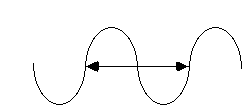You can measure the speed of sound the same way you measure the speed of a runner, with a stopwatch on a closed track.
At 21 degrees C (70°F), you should get 344 meters per second, or 1129 ft per second. At freezing, the numbers are 331 m/s or 1087 ft/s. The proper formula for the change in speed due to temperature is:
![]()
Where T is degrees Celsius. The works out to about a 0.1% change per degree Fahrenheit.
The Speed of sound in water is 1480 m/s or 4856 ft/s. More than 3000 miles per hour.
There is a project under way to take the earth's temperature by measuring the speed of sound between the USA and Australia.
A graph of the air pressure at a certain point might look like this:

The arrow indicates one cycle of the sound. The time it takes to complete a cycle is the period. Frequency is the inverse of this, the number of cycles in a second. The distance sound travels during one period is the wavelength. All this is related by the formulas:
![]()
The upside down y is lambda, which stands for wavelength. P is period, f is frequency, and s is the speed of sound.
The reason we have to be aware of this relationship is that our ears are sensitive to frequency, which we perceive as pitch, but the world works mostly by wavelength. For instance, a trombone manipulates wavelength directly: when the temperature changes, the trombonist must adjust what he does to get the proper pitch.
A 1000 Hz tone has a wavelength a bit under one foot. The wavelength of 440 hz is 2.57 ft or 75.9 cm.
This is a graph of the way sound pressure changes over time for a simple sound:

The curve represents both positive and negative swings around the average pressure. The amount the curve deviates from this average is the amplitude. We hear amplitude of sounds as loudness.
The shape of the curve is very important in establishing the timbre of the sound. The shape of a sound is its waveform.
It's simple really. When sound hits a wall, some bounces back, some doesn't. The unbounced sound either gets lost in the wall or passes through to annoy the next apartment, but from the point of view of the source, it's absorbed. The fraction of the sound that is absorbed (in decimal form) is called the coefficient of absorption. An open window has a coefficient of absorption of 1 at all frequencies. Anything else has a value less than 1 that varies with frequency.
Some Examples:
Total absorption is measured in Sabines, and is calculated by multiplying the coefficient of absorption by the area of material in square feet.
This drawing shows graphs of two sound waves on top of each other. They have the same wavelength and amplitude.

Sound waves can get into this situation a variety of ways:
In all cases, the resulting sound is the sum of the two waveforms. Since the bottom loops of the wave represent negative quantities, the result may actually be less sound than either wave would give by itself. In fact if the waves were placed just right, there may be no sound at all!
That magic effect would happen if the waves were exactly one half wavelength off. We often talk about waves as if they were circular (it's a handy way to describe something that happens over and over) and call this situation 180 degrees out of phase.
All of the causes listed involve a relationship between distance and wavelength. Can you see that if the frequency changed, but nothing else, you could wind up with any amplitude up to twice the original?
Back to talking about diffraction
Back to talking about reinforcement.
This is called the inverse square law. It is often stated "The loudness decreases 6 dB for each doubling of the distance".
Sometimes sound will reach a lot farther than the inverse square law implies. This happens when the energy of the sound is focused somehow rather than distributed evenly on an expanding sphere. Some common situations:
This is what happens. Consider a narrow "beam" of sound. Sound doesn't travel in beams, but I just want to look at a part of the overall picture.Imagine the beam starts in warm air and goes into a region of cool air:

I've drawn two situations. In the first, the beam crosses the boundry between warm and cool at a right angle. All that happens is the wavelength changes. It gets shorter, since the speed of sound is lower in the cool air.
Now look at the beam that strikes the boundry at an angle.The wavefront that has just crossed actually has two wavelengths; long for the part still in the warm air, short for the part in the cold.This makes it skewed. All later waves just propagate off this crooked wavefront, in a new direction.
This effect is more pronounced for long wavelengths, which is why foghorns are low pitched.